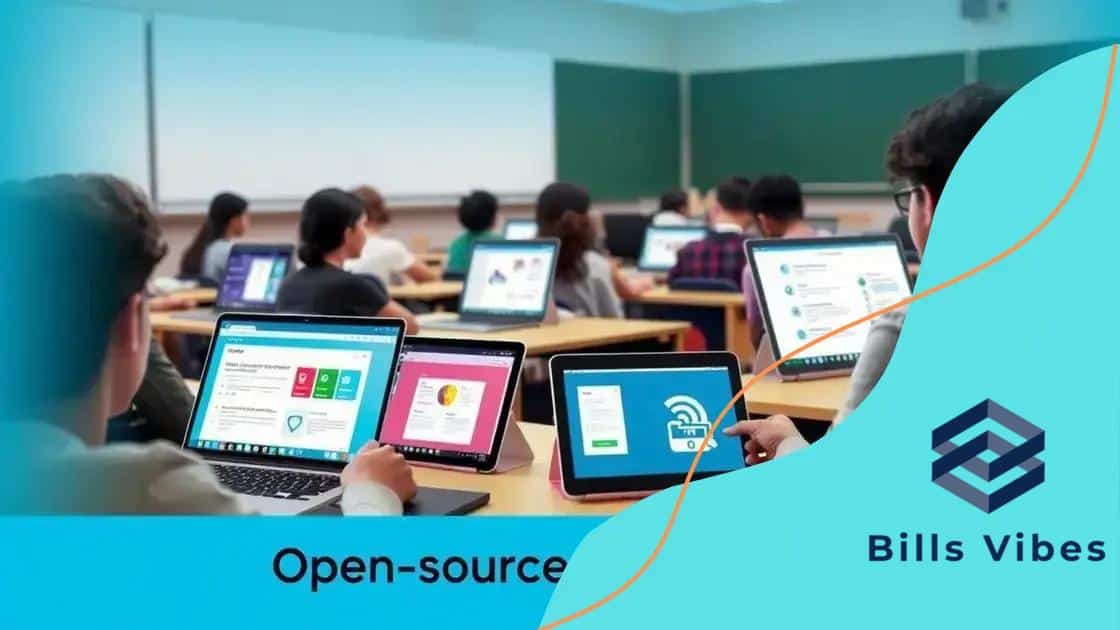Open-source education tools that can transform learning

Open-source education tools provide accessible, customizable resources that enhance collaboration and learning while fostering personalized educational experiences for students and educators alike.
Open-source education tools are changing the landscape of learning, making resources more accessible than ever. Have you ever wondered how these tools could enhance your educational experience? In this article, we’ll dive into their benefits and explore some key platforms.
Understanding open-source education tools
Understanding open-source education tools can open up a world of possibilities for learners and educators alike. These tools are designed to be freely accessible, allowing anyone to use, modify, and distribute them. This approach not only promotes collaboration but also fosters innovation in educational resources.
What Are Open-Source Education Tools?
Open-source education tools refer to various software and resources created with a community-driven philosophy. They often come from collaborative projects, making them rich in features and diverse in application. They can include learning management systems, assessment tools, and instructional materials that enhance the learning experience.
Benefits of Open-Source Education Tools
These tools offer significant benefits that can enhance education:
- Cost-effective resources that can save schools and students money.
- Customization options allowing educators to tailor tools to their specific needs.
- A community support system where users can share knowledge and resources.
Additionally, open-source tools often keep pace with current educational methods and technologies. This adaptability makes it easier for educators to stay relevant in a fast-evolving landscape.
Prominent Examples
Several well-known open-source education tools have gained popularity:
- Moodle: A learning management system used by many educational institutions.
- Canvas: A versatile platform for course delivery and management.
- OpenStack: Useful for developing cloud-based educational applications.
By incorporating such tools, educators can not only enhance their teaching methods but also engage students in more meaningful ways. They provide an opportunity to access quality resources without the high costs typically associated with proprietary software. This opens the door for more equitable learning environments.
Benefits of using open-source tools in education
The benefits of using open-source tools in education are significant and multifaceted. These tools not only lower costs but also enhance collaboration and creativity in learning environments. Teachers and students alike can reap the rewards of having access to flexible resources.
Cost-Effectiveness
One major advantage is the cost-effectiveness of open-source tools. They are typically free to use, meaning that educational institutions can save considerable amounts of money. This makes them accessible to schools and students who might not have the budget for expensive proprietary solutions.
Customization Opportunities
Another key benefit is the ability to customize these tools. Educators can modify them to fit specific teaching styles or curricular needs. This level of adaptability is hard to find in commercial software.
- Personalize features to enhance learning experiences.
- Adjust functionalities based on student feedback.
- Integrate different tools for a comprehensive approach.
Furthermore, when educators collaborate using open-source tools, they can share improvements and innovations. This communal effort often drives better results and encourages teaching practices that are more aligned with modern pedagogical standards.
Fostering Community and Collaboration
Using these tools can also foster a sense of community among users. Educators and students can contribute to improvement and help shape the resources they rely on. This collaborative atmosphere leads to a richer educational experience.
Moreover, as more people engage with open-source education tools, the pool of shared knowledge grows. Users can access forums, tutorials, and other forms of support that might not be available with proprietary options. Such resources help everyone to improve their skills and knowledge.
Top open-source education platforms

When exploring open-source education platforms, several standout options can greatly enhance the learning experience. These platforms provide flexible and powerful resources for both educators and learners, making them invaluable in today’s educational landscape.
Moodle
Moodle is one of the most recognized open-source learning management systems (LMS). It offers a wide range of features that allow teachers to create personalized learning environments. Educators can develop courses, grade assignments, and facilitate interactive activities, all in one place.
Canvas
Canvas is another popular platform, known for its user-friendly interface and robust capabilities. It supports a variety of teaching methods and integrates seamlessly with numerous educational tools. This flexibility makes it appealing to both teachers and students.
Google Classroom
While not entirely open-source, Google Classroom is free and highly functional. It integrates with other Google services and provides an easy way for educators to administer assignments and collaborate with students. Its accessibility makes it a common choice among educators.
Open edX
Another noteworthy platform is Open edX, which is ideal for creating massive open online courses (MOOCs). It allows institutions to deliver large-scale educational content, reaching a broader audience and fostering a learning community.
- Provides analytics to track student performance.
- Supports various multimedia formats for engaging content.
- Encourages peer-to-peer interaction to enhance learning.
These platforms exemplify how open-source education tools can make education more accessible and engaging. They empower educators to create diverse learning experiences that cater to different student needs, ultimately fostering a culture of collaboration and innovation.
How to implement these tools in your learning
Implementing open-source education tools in your learning can be a straightforward process. By following a few steps, you can make the most of these resources to enhance your educational experience.
Identify Your Needs
First, assess what you need for your learning journey. Consider whether you require tools for collaboration, content management, or assessment. By understanding your requirements, you can choose the right tool suitable for your goals.
Choose the Right Platform
Next, research and select the open-source platforms that best meet your needs. Here are a few popular options:
- Moodle: Great for creating course materials and managing assignments.
- Canvas: Known for its intuitive interface and integration capabilities.
- Open edX: Ideal for developing online courses for a broader audience.
Once you’ve identified the platforms aligning with your requirements, you can move on to the next steps.
Set Up Your Tools
After selecting the appropriate tool, the next step is the setup process. Most platforms have user-friendly interfaces that guide you through creating an account and setting up your courses. Engage in tutorials available on these platforms to ensure a smooth setup experience.
Engage with the Community
A significant advantage of open-source education tools is the community support. Participate in forums, join groups, and connect with other users. You can learn best practices and share insights about how to use the tools effectively.
Moreover, leveraging feedback from peers can help improve your learning experience and encourage you to explore new functionalities within the platforms.
Experiment and Adapt
Finally, don’t hesitate to experiment with different tools and approaches. Open-source education tools are designed to be flexible, so feel free to adapt them as needed. Testing various features can help you find the most effective methods for your learning style.
Future trends in open-source education
The future trends in open-source education are set to redefine how learning materials are created and accessed. As technology advances, these tools are becoming more integrated and user-friendly, making education more accessible to everyone.
Increased Collaboration
One of the most significant trends is the rise in collaboration among educators across the globe. Open-source platforms allow teachers to share resources and ideas. This trend fosters a community-driven approach where best practices can be disseminated quickly.
Personalized Learning Experiences
Another critical trend is the shift towards personalized learning experiences. Educators are using open-source tools to tailor learning materials to meet individual student needs. By leveraging data from open-source education tools, teachers can provide customized lesson plans and assignments.
- Analytics to track student progress.
- Adaptive learning technologies that adjust to student performance.
- Customized resources based on learning styles.
Such personalized approaches are expected to improve student engagement and outcomes, making learning more effective.
Integration of AI and Machine Learning
As we look ahead, the integration of artificial intelligence (AI) and machine learning within open-source education platforms is promising. These technologies can analyze student behavior and foster a more interactive educational environment. By utilizing AI, platforms can recommend resources and suggest improvements for both teachers and students.
Focus on Lifelong Learning
Open-source education tools will increasingly support the trend of lifelong learning. In our ever-changing world, individuals are seeking opportunities to upskill or reskill. Open-source platforms provide ongoing learning opportunities that adapt to various career paths.
Offering resources that anyone can access helps bridge the gap between formal education and professional development. This trend emphasizes the importance of learning beyond the traditional classroom setting.
FAQ – Frequently Asked Questions about Open-Source Education Tools
What are open-source education tools?
Open-source education tools are software and resources that are freely available for anyone to use, modify, and share, enhancing collaboration in learning.
How can I benefit from using open-source education platforms?
By using these platforms, you can access a wide range of customizable resources, reduce costs, and engage with a community of educators and learners.
Can open-source tools support personalized learning?
Yes, many open-source tools offer features that allow educators to tailor learning experiences to meet individual student needs.
What trends are shaping the future of open-source education?
Future trends include increased collaboration, AI integration, and a focus on lifelong learning opportunities that make education more accessible.






